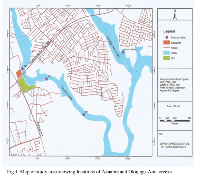Assessment of Heavy Metals (Zn, Pb, Cr and Cd) Levels in the Gill, Intestine and Flesh of Oreocromis niloticus and Liza grandisquamis obtained from Azuabie and Okujagu-Ama creeks in the Niger Delta, Nigeria.
Keywords:
Heavy metals, Fish, Azuabie and Okujagu-Ama creek, Niger DeltaAbstract
The Azuabie and Okujagu-Ama creeks, are prone to pollution due to the discharge of industrial, domestic and abattoir wastes into the creeks. The aim of this study was to assess the level of some heavy metals (Zn, Pb, Cr and Cd) in the gill, intestine and fleshy tissue of Oreochromis niloticusand Liza grandisquamis obtained from the creeks. Fish Samples were analysed following the method of ASTM and determined using Atomic Absorption Spectrophotometery. Results indicated fish samples examined generally had elevated concentrations of heavy metals. In the gill and intestine of Orechromis niloticus, it was observed that Zn>Cr>Pb>Cd but in the fleshy tissue Zn>Pb>Cd>Cr but generally, Zn had the highest concentration in the different parts of the fish examined. Also, in the tissues of Liza grandisquamis, it was observed that generally, Zn>Cr>Pb>Cd. Though, individual metals varied in concentrations, the gill, intestine and flesh of both species of fish samples did not show significant difference (p>0.05) in their metal levels. The t-Test of significance for each metal between the two creeks was also not significantly different (P>0.05), implying that metal concentrations in fish from the two creeks were almost the same. It was however, noticed that the concentration of metals in fish from the creeks generally exceeded limits in sea food set by WHO, FAO and FEPA. Conclusively, there was gradual bioaccumulation and possible biomagnefication of heavy metals in fish from Azuabie and Okujagu-Ama creeks and this could be a risk for consumers of sea food from such presumed polluted areas.
Downloads
References
Adeyemi, O.G., Adediran, G.O. and Oyeniyi, T. (1996). Some trace elements concentration in a variety of fishes from Asa River, Ilorin, Nigeria. Bioscience Research Communications 8 (2): pp.99-102.
Agada, E.G.O. (1994). Heavy metals concentration in selected fish fauna of Warri river and its tributaries, Ph.D. Thesis, University of Benin, Benin City.
Agbozu, I.E. and Ekweozor, I.K.E. (2001). Heavy metal levels in a non-tidal freshwater swamp in the Niger Delta area of Nigeria. Africa Journal of Science, 2, 175-182.
Ashraf W (2006). Levels of selected heavy metals in tuna fish. Arabian J. Sci. Technol. 31: 89-92.
Atuma, S.O. and Egborage, A.B.M. (1986). Insecticides and metals in Nigeria Surface waters-Warri River. International Journal of Environmental Studies, 27, 139-142.
Chezhieon, A., Kabilan, N., Suresh Kuma, T., Senthanol-Selvan, D. and Sivakumari, K. (2010). Impact of common mixed effluent of sipcol industrial estate on histopathological and biochemical changes in estuaries fish latescalcrifer. Current Research Journal of Biological Sciences, 2(3),
-209.
Daka, E.R., Ekeh, C.A. and Moslen, M., (2008): Cadmium and lead level in some fish species from Azuabie creek in the Bonny Estuary, Nigeria. African J. Biotech., 7, pp.63-64.
Department of Water Affairs and Forestry, (1996). Water Quality Guidelines, Aquatic Ecosystem. Use Volume 7, 1stEd. DWF, Pretoria.
Elnabris, K.J., Muzyed, S.K. and El-Ashgar, N.M. (2013). Heavy metal concentrations in some commercially important fishes and their contribution to heavy metals exposure in Palestinian people of Gaza Strip (Palestine). J Assoc Arab Univ Basic Appl Sci. 13, 44-51.
FAO. (1983). Compilation of legal limits for hazardous substances in fish and fishery products. FAO Fishery Circular No. 464. Food and Agriculture Organization; pp. 5-100.
FEPA, (2003): Guideline and Standards for Environmental Pollution and Control in Nigeria. Federal Environmental Protection Agency, Nigeria.
Guo T, Delaune RD, Patrick Jr WH (1997). The influence of sediment redox chemistry on chemically active forms of arsenic, cadmium, chromium, and zinc in the estuarine sediment. Int. J. Environ. Stud. (23): pp.305–316.
Ibok, U.J., Udosen, E.D. and Udoidiong, O.M. (1989). Heavy metals in fishes from some streams in Ikot Ekpene area of Nigeria. Nigerian Journal of Technological Research, 1, 61-68.
Kakulu, S.E., Osibanjo, O. and Ajayi, S.O. (1987). Trace metal content of fish and shell fishes of the Niger Delta area of Nigeria. Environment International,13, 247-251
Lindqvist, L. and Block, M. (1994). Excretion of calcium and zinc during moulting in grasshopper Omocestus viridulus (Orthoptera). Environmental Toxicology and Chemistry, 13(10), 1669-1672.
Merian, E., (1991). Metals and their compounds in the environment: Occurrence, Analysis and Biological Relevance. UCH.Weinhein-New YorkBasel-Cambridge.
Moslen, M . and Miebaka, C. A. (2016). Temporal Variation of Heavy Metal Concentrations in Periophthalmus sp obtained from Azuabie Creek in the Upper Bonny Estuary, Nigeria. J. of Cur. Stud. in Compr. Edu. Sci. and Tech. 3(2): 136-147.
Nwaedozie, J.M. (1998). The determination of heavy metal pollution in some fish samples from River Kaduna. Journal of the Chemical Society of Nigeria, 23, 21-23.
Omoregie E, Okoronkwo MO, Eziashi AC, Zoakah AI (2002). Metal concentrations in water column, benthic macroinvertebrates and tilapia
from Delimi River, Nigeria. J. Aquat. Sci. (17): pp.55–59.
Ramona, A., Biswas, A.K., Kundu, S., Sah, J.K. and Yadv, R.B.R. (2001). Efficacy of distillery effluent on seed germination and seedling growth in mustard cardiflower and radish. Proc. Nat Acad Sci. India, 71(b11), 129-135.
Tam N.F.Y and Wong Y.S. (2000). Spatial variation of heavy metals in surface sediments of Hong Kong mangrove swamps. Environmental Pollution, 110, 195-205.
Udosen, E. D, Essien, J.P. and Ubom, R. M. (2001). Bioamendment of petroleum contaminated soil: Effect on oil content, heavy metals and pH of tropical soil. J. Environ. Sci. pp.92-98.
WHO (1985). Heavy metals environmental aspects; Environment health criteria. No. 85. Geneva, Switzerland
Yadav, A., Neraliy, S. and Singh, R., (2005). Effect of fertilizer industrial effluent in the behaviour and morphology of fresh water cat fish, Heteropenenstes fossils (Bluch), India: Department of Zoology, University of Acoghbord.

Downloads
Published
Issue
Section
License

This work is licensed under a Creative Commons Attribution-NonCommercial-ShareAlike 4.0 International License.







